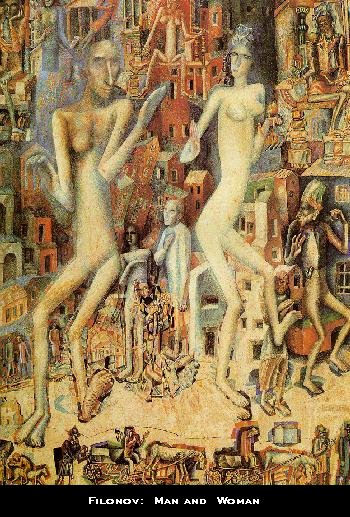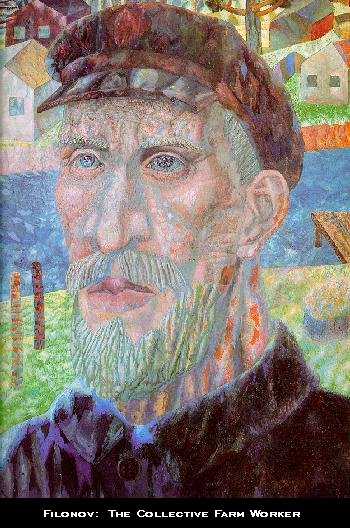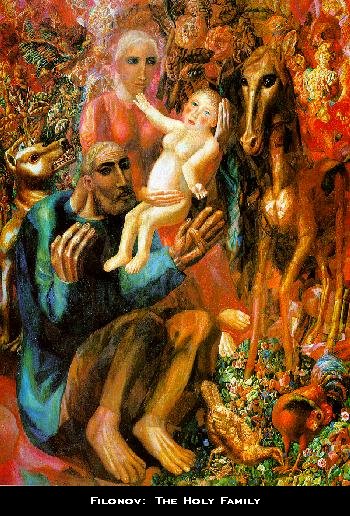

Pavel Filonov was born in Moscow. Early orphaned, he moved to St. Petersburg, where he
began taking art lessons. From 1908 to 1910, he attended the Academy of Arts, but was expelled in 1910. In 1911, he came in contact with the
Union of Youth and contributed to its exhibitions. Next year, he
traveled to Italy and France. In 1913, Filonov designed the stage set for Vladimir Maiakovskii's tragedy Vladimir Maiakovskii. Over the next two years, he worked as an illustrator of futurist booklets, published his transrational poem The Chant of Universal Flowering (Propoved' o porosli mirovoi), and started developing his artistic theories, the so-called Ideology of Analytical Art and the Principle of Madeness (see extracts below). In 1919,
Filonov exhibited at the First State Free Exhibition of Works of Art in Petrograd. In 1923, he became a professor at the Academy of Arts and an associate of the Institute of Artistic Culture (Inkhuk). In the same year, he published the "Declaration of Universal Flowering" in the journal Zhizn' Iskusstva. Two years later,
the painter established the Collective of Masters of Analytical Art (known today as Filonov School). Because of continuing attacks and ostracism, Filonov's exhibition planned for 1929-30 at the Russian Museum did not open. In 1932, he contributed to the exhibition
Artists of the RSFSSR Over the Last 15 Years. His life and creativity was cut short by the war. He died of pneumonia during the siege of Leningrad in 1941. In 1967, he had a posthumous exhibition in Novosibirsk.
Only in recent years Filonov's art received international recognition. The images produced by his mind contributed significantly to the intellectual growth of
the avant-garde in Russia. His artistic character was founded upon some uncompromising ideals to which he was committed, as he demonstrated in the early years of his work by not accepting the ideology of the Academy of Art in St.Petersburg. Filonov left the academy in 1910 and chose to ignore the mainstream current of art to further develop his personal style. Through his art, Filonov sought to observe and understand the forces that comprise the human existence, both the internal and external factors. He aimed to achieve a systematic knowledge of the world and it's human inhabitants. Filonov's paintings were in effect not mere images with meaning; -- his work went beyond that -- they were manifestations of intellectual concepts, something derived from his theory and ideology. The viewer of the art was to observe a "projective intellect" within the imagery. "A picture suggests to the mind of its viewer a single conclusion, which cannot be translated into words."
After the 1917 revolution, Filonov worked to complete the development of his "analytical painting". The changes in the Russian society brought inspiration to the Futurist artists. Filonov dedicated much of his time and effort to artistic research and creativity, working on his paintings as much as 18 hours a day. In 1925, having found many followers and supporters for his style of expression, he founded a school in Petrograd, which was shut down by the government in 1928, together with all other private artistic and cultural organizations.
In "Ideology of Analytical Art" Filonov explains what he expects from his student artists (and, of course, from himself):
A work of art is any piece of work made with the maximum tension of analytical madeness [sdelannost' -- The word is Filonov's neologism, derived from the Russian verb "sdelat'," -- to make, to do. Used in its perfective form, the verb denotes the completion of action].
The only professional criterion for evaluating a piece of work is its madeness.
In their profession the artist and his disciple must love all that is "made well" and hate all that is "not made."
In analytical thought the process of study becomes an integral part of the creative process for the piece being made.
The more consciously and forcefully the artist works on his intellect, the stronger the effect the finished work has on the spectator.
Each brushstroke, each contact with the picture, is a precise recording through the material and in the material of the inner psychical process taking place in the artist, and the whole work is the entire recording of the intellect of the person who made it.
Art is the reflection through material or the record in material of the struggle for the formation of man's higher intellectual condition. Art's efficacity vis-a-vis the spectator is equal to this; i.e., it both makes him superior and summons him to become superior.
The artist-proletarian's obligation is not only to create works that answer the demands of today, but also to open the way to intellect into the distant future.
The artist-proletarian must act on the intellect of his comrade proletarians not only through what they can understand at their present stage of development.
Work on content is work on form and vice versa.
The more forcefully the form is expressed, the more forcefully the content is expressed.
Form is made by persistent line. Every line must be made.
Every atom must be made; the whole work must be made and adapted.
Think persistently and accurately over every atom of the work you are doing. Make every atom persistently and accurately.
Introduce persistently and accurately into every atom the color you have studied -- so that it enters the atom just as heat enters the body or so that it is linked organically with the form, just as in nature a flower's cellulose is linked with its color.
Painting is the colored conclusion of drawing. (Russian Art of the Avant-Garde, 286-7). [D.K. and A.B.] [Sources: The Avant-Garde in Russia, Russian Art of the Avant-Garde, Filonov].


